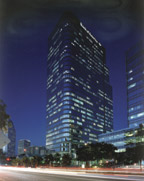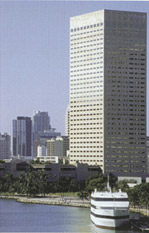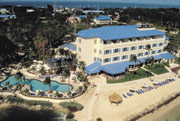Miami: A Few
Diamonds in the Rough
Scott Strickland
 |
|
Teachers Insurance and Annuity
Association (TIAA-CREF) purchased 701 Brickell
in Miami’s CBD late last year. The trophy
tower is now 97 percent occupied and is anchored
by Bank of America and Holland & Knight, according
to Jones Lang LaSalle, the leasing and management
agent.
|
|
Despite slow-moving demand, Miami appears to be in a relatively
advantageous spot. In line with one of its core economic bases,
Miami has been recognized by AmericaEconomia as “the
best city for doing business in Latin America” —
for the third year in a row. In addition, corporate executives
indicated that they would choose Miami among world cities
as the top destination for their Latin American headquarters.
As a dominant player in the state, Miami continues to benefit
from Florida’s strong position. Florida is one of two states
to lead the nation in personal income growth, and it led the
nation in job growth during February 2003. Additionally, Florida
has the largest service sector — the prime users of office
space — in the entire Southeast, according to the Federal
Reserve Bank of Atlanta. Demographic trends point to continued
growth in Miami’s population and a strong consumer spending
base, noted by the Bal Harbour Shops’ recent ranking as
the most productive shopping center in the U.S. — generating
sales more than “three times the national average at $1,350
per square foot” (Women’s Wear Daily). Miami’s
business resiliency remains impressive, having ranked third
in the U.S. for increases in business establishments (2000 to
2001), following California’s Los Angeles and Orange counties,
according to the most recent statistics from the U.S. Commerce
Department’s Census Bureau.
First Quarter Market Dynamics
As anticipated, flat market conditions characterized much of
the first quarter, as the general state of office leasing remained
relatively quiet. Reversing last quarter’s small but positive
absorption, new occupancy was negative 83,000 square feet while
overall vacancy rose to 14 percent. Despite a decline in new
construction starts of almost 50 percent between 2001 and 2002,
Miami’s current pace of construction will still result
in an additional 1 million square feet of Class A inventory
by the end of 2003. While construction is forecast to decline
again in 2004, vacancy is anticipated to remain at the 2003
level, estimated at 15 percent.
Concessionary pricing by tenants with excess space and by owners
of new developments continues to provide fertile ground for
value-shopping tenants. As a result, some traditional occupiers
of Class B space are taking the opportunity to upgrade to Class
A space and other tenants are taking the opportunity to relocate
to lock in favorable rental rates on long-term leases, often
for less space than they last occupied. While such moves create
the perception of activity, these transactions do little to
improve the health of the overall market as net absorption is
generally unchanged by lateral moves and market prices decline
as a reflection of increased competition.
CBD Trophy Towers Stand Tall
 |
|
Miami Center is 96 percent occupied.
The combined overall occupancy rate among competitive
downtown trophy buildings dipped one point to
91 percent — still amazingly healthy compared
to other major U.S. cities.
|
|
Along the prized Brickell Avenue corridor, a 2003 recovery
of the financial district is unlikely due to the delivery
of new office space and weak demand among financial institutions.
Still, most of the competitive Class A trophy towers are stabilized,
maintaining high occupancy levels with gross asking rental
rates at or above $30 per square foot. These are among the
set of properties that fueled interest by institutional investors
last year in Miami’s CBD and resulted in record sale
transactions — both in terms of volume and increasing
price values.
“The top-performing Class A buildings are further distinguished
by having nationally based anchor tenants — law firms,
insurance agencies and banks, typically the largest office users
in the CBD,” notes Eric Siegrist, leasing director and
vice president at Jones Lang LaSalle. Bank of America and Holland
& Knight has leased space at 701 Brickell, the submarket’s
occupancy leader, while Greenberg Traurig has taken space at
1221 Brickell and Aon Risk is leasing at Brickell Bay Office
Tower.
Fundamental indicators also remain stable in the downtown competitive
Class A segment of the CBD, as key law firm tenants test the
market. Law firms are doing their share to maintain healthy
occupancy levels in downtown by renewing and expanding leases.
In a South Florida Business Journal ranking of the “Largest
Law Firms,” downtown boasts 11 of the top 25 and six of
the top 10. The overall vacancy rate among the three competitive
Class A office towers registered less than 7 percent with quoted
prices on direct space popping up to $31.15 per square foot
in the first quarter. Siegrist adds that this “reflects
the relative ‘tightness’ of the submarket and the
added pressure to meet higher pro forma rents as a result of
recent and current building sales activity.” The wave of
investment sale activity, however, is not quite over as the
CBD has two buildings currently on the market: 1200 Brickell
on Brickell Avenue and Bank of America Tower at International
Place in downtown.
Hotel Scene
 |
|
Cheeca Lodge & Spa –
Islamorada, the Florida Keys: While the Keys have
implemented a moratorium on hotel building, Miami’s
inhibitions have resulted in relatively unrestrained
hotel development.
|
|
“While the Miami lodging industry continues to come
to terms with a prolonged funk, the Conch Republic to the
south is enjoying an enviable run more typically associated
with bull markets and increasing disposable incomes,”
notes Gregory Rumpel, a senior vice president with Jones Lang
LaSalle Hotels. The backdrop to the Florida Keys’ success
has been a combination of geography, lifestyle and a moratorium
on hotel construction. In contrast, Miami continues to deliver
a superb tourist experience but has also had an unbridled
supply of hotel development provided by enthusiastic developers.
The results have everyone concerned, particularly lenders who
have seen continued erosion in profitability without any quick
fixes being offered by seasoned and experienced hotel managers.
Rumpel further indicates that the mantra has been, “Control
costs, focus on the guest and wait for the market to recover…
and, of course, we don’t need any more new hotels, thank
you!”
The experience in the Florida Keys once again provides compelling
evidence that the long-term health of the lodging industry is
a delicate balance of “supply and demand.” Markets
with limited development opportunities or high barriers to entry
are much better equipped to shrug-off a sluggish economy, geopolitical
risks and their associated neuroses. These same markets are
the quickest to recover as they generally have less ground to
make up.
The double jeopardy currently being played out in Miami’s
lodging market is the weakness in demand running headlong into
the ballooning supply of luxury hotels. The result — a
disappointing performance posted by many outstanding hotels
and their experienced management teams. The good news is that
Miami is still the same sun, sand and sea sensation that it
always has been. With Miami’s latest round of high quality
hotel development nearing completion, it now boasts a greatly
improved infrastructure and significant capacity. Rumpel adds
that “the short-term prognosis may be painful, but if we
take a slightly longer-term view of the market, fundamentals
are well established for a continued vibrant lodging sector
in South Florida.”
Scott Strickland is a leasing director with Jones Lang
LaSalle.
Scarcity of Land
in South Florida Presents New Retail Opportunities
|
Miami’s Retail
Market Benefits from High Level of Activity
|
©2003 France Publications, Inc. Duplication
or reproduction of this article not permitted without authorization
from France Publications, Inc. For information on reprints
of this article contact Barbara
Sherer at (630) 554-6054.
|
